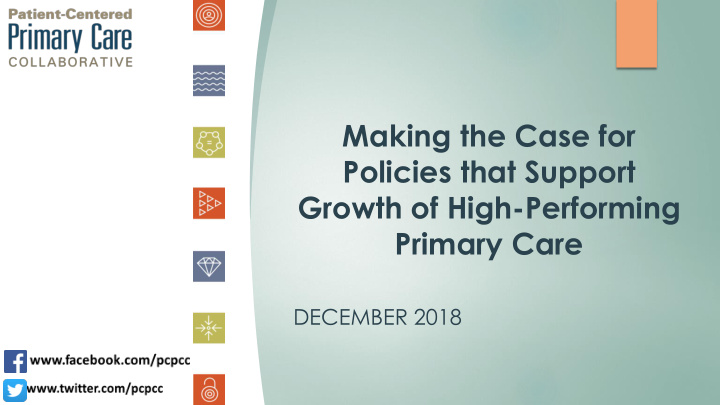



Making the Case for Policies that Support Growth of High-Performing Primary Care DECEMBER 2018
PCPCC Quadruple Aim MISSION Promote Robust Primary Care to Achieve the Quadruple Aim VISION Shared Principles of Primary Care Updates 2007 PCPCC Joint Principles Nearly 300 Signatories to Date
What are we spending now on primary care? Hospital Care 1.80% 3.30% 5.90% Studies show that the percentage All Other Physician and of total U.S. healthcare spending Professional Services 4.40% on primary care is 5.8%-7.7% Prescription Drugs and Other 6.00% 38.30% Medical Nondurables Nursing Home Care 13.80% Even among high performing Dental Services health plans, primary care spending varies widely Home Health Care 19.50% Medical Durables Primary Care Other Health, Residential, and (estimated commercial) Personal Care
Spending on office visits to primary care physicians How is that declined 6% from 2012 to 2016 - NP & PA substitution is a contributor spending - But, there was still an overall 2% decline in PC visits, inclusive of MDs, NPs, and PAs changing? During the same period, spending on specialists increased by 31%
What do we lose when we underinvest in primary care? Access to Needed Services: Prevention: As of 2015, only 8% of US adults ages >/= 35 received all high-priority, appropriate preventive services recommended. Nearly 5% of adults did not receive any such services. Chronic Care Management: 85% of primary care providers said they don’t have enough time to focus on a patient’s chronic disease management needs Behavioral Health: Higher primary care Medicaid reimbursement rates improve behavioral health outcomes among enrollees, indicating that primary care is efficient in improving behavioral health outcomes.
What do we lose ? (continued) Needed Primary Care Workforce: From 2005 — 2015 PCPs as a % of total practicing physicians decreased from 44% to 37%. From 2005 — 2015 the number of PCP jobs grew by approximately 8%, while the number of jobs for specialists grew by approximately 6X that amount. Less than half of PCPs report that they would choose primary care if they could choose again (25%-46% depending on specialty). Compared with peer countries, the U.S. has fewer primary care clinicians and provides fewer primary care services.
The Importance of Primary Care There is a Fundamental Disconnect Between How Primary Care is Valued, e.g., Primary Care Spend, Primary Care’s Place in the Delivery System
What does the evidence indicate we should spend on primary care? 12% Primary Care Investment , OECD 2013 U.S. healthcare markets with a larger percentage of PCPs have lower spending and higher quality. Leading researchers suggest that doubling primary care spending -- to 10 – 12% of total health care spending -- would likely pay for itself through resulting reductions in overall health spending
How Do We Change this Dynamic?
Role of the PCPCC Policy Solution: Increase Investment in Primary Care via APMs, including PCMHs, to Enhance Value ✓ Agreed upon measure of primary care spend – raise visibility, benchmark, catalyze research and action ✓ Use evidence to make the case to increase PC Investment ✓ Define consensus recommendations for increasing primary care investment ✓ Inform state legislative/regulatory efforts
PCPCC Consensus Recommendations on Increasing Primary Care Investment Evaluate Outcomes: Set Clear Goals: Define the Challenge : Evidence-based with S trengthen the ability Standardized measure appropriate outcome of primary care to to track and report evaluation achieve the quadruple aim Align Payment : Engage Stakeholders: through targeted Implemented through Broad stakeholder strategies that payment models that engagement and support unmet needs align incentives participation across participants, representing all parts including consumers of the community and healthcare delivery system
State Oregon Rhode Island Per regulation, RI 2017 legislation measured and mandated an Leadership increased its primary increase in primary care spend by all care spending from to Date health plans to 12% 5.7% in 2008 to 9.1% by 2023 in 2012. Many other states are Delaware leading, through In 2018, Delaware legislation: passed primary care legislation that may lead to an Oregon- • Colorado like transformation. • California Stay tuned for an • Vermont update in January.
Spotlight on Rhode Island
Spotlight on Rhode Island
Spotlight on Rhode Island
Spotlight on Oregon: Multi-Prong Approach Focus on Practice Transformation : 2009 initiated PCPCH; today @ 90% of Oregon primary care practices recognized as PCPCH Medicaid Program Coordinates with Community Services : CCOs initiated in 1990 waiver and evolved overtime with successive waivers, which gave MCOs flexibility on spend. Primary Care Payment Reform Collaborative: 2015 review of primary care spend across OR health plans showed wide variance of 6% to 18%
► Portland State University report on Oregon PCPCH program (Sept 2016) showed Making the impressive results: ► Demonstrated a 4.2% reduction in per Case to the member cost ► $13 savings for every $1 spent on primary care by avoiding unnecessary hospital & Oregon sub-specialty care Legislature Given this evidence, in 2017 Oregon passed legislation unanimously to increase primary care investment to 12% by 2023.
► 5 states have enacted or introduced legislation ► 6 additional states have indicated a desire to work on efforts to report or increase PC spend in 2019 Lighting Prairie Fires Across the Country in Anticipation of a National Conversation in 2020
The perfect primary care spend measure Curve Balls and arguments about what is in/out to Avoid The pristine all payer database Discounting the importance of examining current PC spend Over promising that increasing primary care spend is a silver bullet that solves all health system ills
1. Baseline and ongoing measurement — begin the conversation 2. Raise visibility of the issue — comparisons within and across states can help drive the narrative 3. Who are your spokespeople? Multi-stakeholder leadership and advocacy is most successful 4. Evidence Dissemination — Savings and patient outcomes can change hearts and minds 5. Connect with the PCPCC — https://www.pcpcc.org/resource/primary-care-investment-workshop Next Steps
Contact Ann Greiner, President and CEO Chris Adamec, Director of Policy 202-417-2062 202-640-1212 agreiner@pcpcc.org cadamec@pcpcc.org @PCPCC @PCPCC www.pcpcc.org www.pcpcc.org
Recommend
More recommend